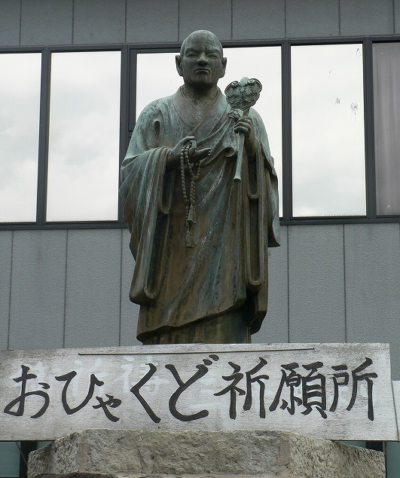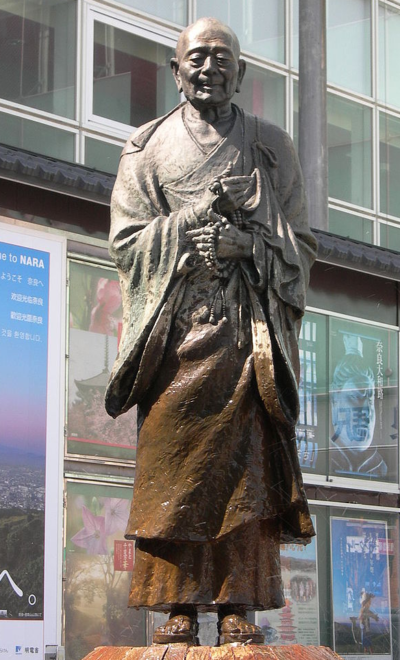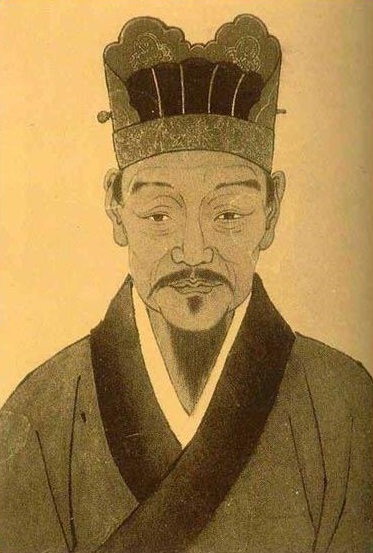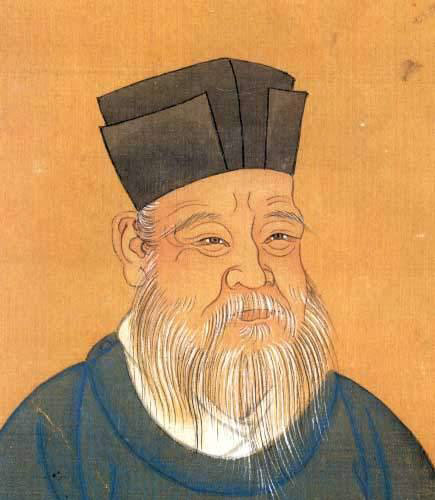行基 東大寺の「四聖」 大仏造立の歴史的経緯とその生涯の軌跡

Gyoki and the “Four Saints” of Todaiji: Historical Background of the Great Buddha Construction and His Life’s Journey
イントロダクション
行基は、奈良時代の僧侶であり、東大寺大仏の建立に深く関わったことで知られています。
彼は「四聖」として敬われ、その生涯は仏教的な理念と社会貢献の模範とされています。
この記事では、行基の歩んだ歴史的軌跡を探り、大仏造立に至るまでの経緯と彼の生涯に迫ります。
読者は、日本仏教史におけるこの偉大な人物の足跡をたどりながら、彼の精神的遺産に触れることができるでしょう。
序章:行基とは-奈良時代の偉大な僧侶
行基は、奈良時代に活躍した仏教僧であり、多くの伝説に彩られた人物です。
彼の生涯は、日本の仏教史だけでなく、社会史にも大きな影響を与えたとされています。
行基は、庶民に対する慈善活動や、橋や灌漑施設の建設など、福祉事業にも力を注ぎました。
これらの活動は、後の日本の社会基盤整備の礎となり、彼の名を不朽のものにしました。
特に注目すべきは、東大寺との関わりです。
行基は東大寺の創建に深く関わり、その過程で「四聖」として尊敬を集めました。
東大寺の大仏造立は、行基の強い信仰心と、当時の日本における仏教の位置づけを象徴する出来事であり、彼の影響力の大きさを物語っています。
奈良の大仏は、現在も多くの人々に親しまれ、日本の仏教文化を代表する存在となっています。
行基の功績は、その死後も多くの文献や伝承によって語り継がれており、奈良時代の僧侶としてだけではなく、日本の歴史における偉大な人物として記憶されています。
彼の生きた時代から遠く離れた今日でも、行基の精神は、多くの寺院や文化遺産を通じて、私たちの心に息づいています。
行基の生涯と業績
行基は奈良時代に活躍した僧侶で、その生涯は多くの伝説に彩られています。
彼は民衆の信仰を集め、多くの社会貢献活動を行ったことで知られています。
広く慈善事業を展開し、橋を架け、井戸を掘り、病院や宿泊施設の建設など、人々の生活向上に尽力しました。
また、行基は仏教の普及にも貢献し、多くの寺院建立に関わりました。
特に、東大寺と行基の関係は深く、彼は東大寺の「四聖」の一人に数えられています。
東大寺の大仏造立にも関与したとされる行基は、奈良の大仏として知られるこの巨大な仏像の建立によって、日本仏教史における重要な人物としての地位を確立しました。
奈良の大仏は、東大寺の象徴であり、日本の仏教文化を代表する存在となっています。
行基の業績は、彼の慈悲深い行動と仏教への深い信仰心によって支えられていました
。彼の生涯と功績は、現代においても多くの人々に尊敬され、奈良時代の歴史を語る上で欠かせない要素となっています。
そのため、行基について学ぶことは、日本の文化や歴史に深い理解を得るためにも重要です。
東大寺と行基の関わり
奈良時代に活躍した行基は、今なお多くの人々に尊敬される僧侶です。
彼の名前は、慈悲深く民衆の生活を改善しようとした姿勢と、数多くの寺院建設に関わったことで知られています。
特に、東大寺との関連は深く、行基はその創建に大きな影響を与えた人物として記憶されています。
行基は、東大寺の「四聖」の一人としても称えられており、その功績は奈良の大仏造立にも大きく寄与しています。
彼は、東大寺大仏殿の建立を支援し、仏教の普及に尽力したことで知られています。
奈良の大仏は、東大寺の象徴であり、行基の精神的な遺産ともいえるでしょう。
行基の生涯を通じて、彼が築き上げた多くの寺院や橋などの公共事業は、当時の人々の生活に大きな影響を与えました。
彼の仏教に対する深い信仰と行動力は、東大寺だけでなく、日本全国における仏教文化の発展に貢献したのです。
東大寺と行基の関わりは、単に建築物の創建に関するものではありません。行基の精神は、東大寺を通じて、後世に仏教の教えを伝え、人々の心に深く根ざしていくことになりました。
そのため、東大寺は、行基の遺した精神的な遺産として、今日まで多くの人々に親しまれているのです。
Introduction
Gyoki, a monk of the Nara period, is renowned for his deep involvement in the construction of the Great Buddha at Todaiji Temple.
Honored as one of the “Four Saints,” his life exemplifies Buddhist ideals and social contributions.
This article explores the historical trajectory of Gyoki’s journey and delves into his life leading up to the establishment of the Great Buddha.
Readers will trace the footsteps of this eminent figure in Japanese Buddhist history, touching upon his spiritual legacy.
Chapter 1: Gyoki – A Great Monk of the Nara Period
Gyoki, a prominent Buddhist monk of the Nara period, is a figure surrounded by many legends.
His life left a significant impact not only on Japan’s Buddhist history but also on its social fabric.
Gyoki dedicated himself to charitable activities among the common people, constructing bridges, irrigation facilities, and engaging in welfare projects.
These initiatives laid the foundation for later developments in Japan’s social infrastructure, ensuring his name remained immortalized.
Of particular note is his association with Todaiji Temple.
Deeply involved in its foundation, Gyoki garnered respect as one of the “Four Saints” of Todaiji.
The construction of the Great Buddha at Todaiji stands as a testament to Gyoki’s profound faith and the stature of Buddhism in Japan at that time, underscoring his immense influence.
Nara’s Great Buddha continues to be revered today, representing a cornerstone of Japanese Buddhist culture.
Gyoki’s achievements are enshrined in numerous scriptures and traditions, remembered not only as a monk of the Nara period but as a great figure in Japanese history.
Even today, separated by centuries from his lifetime, Gyoki’s spirit resonates through many temples and cultural heritage sites, dwelling in our hearts.
Gyoki’s Life and Accomplishments
Gyoki, an active monk of the Nara period, is celebrated for a life colored by numerous legends.
He garnered widespread faith among the populace and engaged in extensive social welfare activities.
His philanthropic endeavors included building bridges, digging wells, establishing hospitals, and lodging facilities, all aimed at improving people’s lives.
Furthermore, Gyoki contributed to the spread of Buddhism, participating in the establishment of many temples.
Particularly noteworthy is his deep connection with Todaiji Temple, where Gyoki is honored as one of the “Four Saints.”
Gyoki’s involvement in the construction of Todaiji’s Great Buddha established his prominent position in Japanese Buddhist history.
Nara’s Great Buddha, as a symbol of Todaiji, represents a profound spiritual legacy of Gyoki.
Throughout his life, Gyoki’s extensive public works, such as temples and bridges, profoundly impacted the lives of people at that time.
His deep faith in Buddhism and his proactive actions contributed to the development of Buddhist culture not only in Todaiji but throughout Japan.
The association between Todaiji and Gyoki extends beyond mere architectural construction. Through Todaiji, Gyoki’s spirit continues to transmit Buddhist teachings through the ages, deeply rooted in people’s hearts.
Therefore, Todaiji Temple remains beloved by many as a spiritual legacy left by Gyoki.

Bronze Statues at Kehara-ji Temple
行基と東大寺の「四聖」
行基は奈良時代に活躍した僧で、多くの伝説に彩られた人物です。
彼は、奈良の大仏で知られる東大寺の創建に深く関わったことで有名です。
東大寺の「四聖」とは、行基を含む四人の僧を指し、それぞれが東大寺の歴史において重要な役割を果たしました。
東大寺「四聖」とは、行基、良弁、重源、公慶の四人の僧を指します。
彼らはそれぞれ異なる時代に東大寺に関わり、その発展に寄与しました。
行基はその中でも特に大仏造立の中心人物とされ、彼の強い意志と行動力が大仏建立の原動力となりました。
良弁は、東大寺の開山とされる高僧であり、東大寺大仏の開眼供養を行ったことで知られています。
彼の働きにより、東大寺は日本仏教の中心地としての地位を築きました。
重源と公慶は、平安時代末期から鎌倉時代にかけての僧で、東大寺の再建に尽力しました。
特に重源は、東大寺大仏殿の再建を行い、その後の東大寺の復興に大きく貢献しました。
公慶もまた、重源の弟子として東大寺の復興に関わり、その歴史に名を刻んでいます。
これらの僧たちは、東大寺とともに奈良の文化や歴史に大きな影響を与えており、今日に至るまでその功績は高く評価されています。
彼らの生きざまは、信仰心と行動力を兼ね備えた模範として、後世に多大な影響を与え続けています。
東大寺「四聖」とは
東大寺には「四聖」と称される四人の重要な人物がいます。
これらの人物は、奈良時代から鎌倉時代にかけて東大寺に関わり、それぞれが寺の歴史において大きな役割を果たしました。
行基は、奈良の大仏を造立するプロジェクトの中核を担った僧であり、彼の尽力によって東大寺の大仏、すなわち国宝である盧舎那仏像が完成しました。
彼はまた、貧しい人々への施しや橋の建設など、社会貢献活動にも積極的に関わったことで知られています。
良弁は東大寺を開いた高僧として知られており、彼の指導のもと、東大寺は学問と修行の中心地として発展しました。
彼はまた、聖武天皇による国家仏教のプロジェクトにも関わり、その知識と信念が東大寺の基盤を築くのに貢献しました。
鎌倉時代初期には、重源と公慶という二人の僧侶が東大寺の復興に尽力しました。
平安時代末期の戦乱で荒廃した東大寺を再建するため、彼らは多大な努力をし、その結果、東大寺は再び栄えることとなりました。
これらの「四聖」はそれぞれ異なる時代に活躍し、東大寺という歴史的な寺院の発展に欠かせない貢献をしました。
彼らの物語は、日本の宗教史だけでなく、社会史においても重要な部分を占めています。
行基-大仏造立の中心人物
行基は奈良時代に活躍した高僧であり、東大寺の大仏造立において重要な役割を果たした人物です。
彼は「四聖」の一人として、東大寺の創建と大仏の建立に尽力しました。
東大寺「四聖」とは、行基をはじめ、良弁、重源、公慶の四人の僧を指し、それぞれが東大寺に関わる異なる時代において重要な貢献をしました。
行基は、人々の心の救済を願い、多くの利益をもたらす大仏造立のプロジェクトを推進しました。
彼の信念と行動力は、奈良の大仏(東大寺)造立において中心的な役割を果たし、後の世に大きな遺産を残しました。
良弁は、東大寺を開いた高僧として知られ、仏教教義の普及に努め、多くの弟子を育てました。
彼の教えは、日本仏教の基礎を固めることに寄与しました。
また、重源と公慶は、平安時代末から鎌倉時代にかけて東大寺の復興に尽力した僧侶たちです。
特に重源は、東大寺大仏殿の再建を主導し、日本の文化財保護に大きな足跡を残しました。
このように、行基をはじめとする「四聖」は、東大寺と奈良の大仏造立において、それぞれ異なる時代において重要な役割を果たし、日本の仏教文化の発展に寄与したのです。
彼らの功績は、今もなお多くの人々に敬われ、東大寺とともに日本の歴史に刻まれています。
良弁-東大寺を開いた高僧
奈良時代に活躍した高僧、行基は東大寺の大仏造立において中心的な役割を果たしました。
彼は広く民衆から信仰を集め、東大寺の「四聖」の一人としても尊敬を受けています。
東大寺「四聖」とは、東大寺とその大仏造立に深く関わった四人の僧侶を指し、行基のほかに良弁、重源、公慶が名を連ねます。
良弁は東大寺開山の高僧として知られ、奈良の大仏、すなわち東大寺の大仏造立にも深く関与しました。
彼は仏教教義の普及に努め、多くの信者に支持されたことで、その名は今なお伝えられています。
また、重源と公慶は、平安時代末から鎌倉時代にかけて東大寺の復興に尽力した僧侶たちです。
特に重源は、東大寺大仏殿の再建を行い、その功績で知られています。
公慶もまた、東大寺の復興に貢献したことで、後世に大きな足跡を残しました。
これらの僧侶たちの生涯と業績は、東大寺だけでなく、日本の仏教史においても重要な役割を占めています。
彼らの献身的な活動は、今日に至るまで多くの人々に敬意を表され、東大寺と共にその教えが受け継がれているのです。
重源と公慶-東大寺の復興に尽力した僧侶たち
東大寺は奈良時代に創建された日本最古の官寺であり、その歴史は高僧行基によって大きく彩られています。
行基は、人々の信仰の中心となる大仏を造立するプロジェクトの推進力となりました。
彼の尽力により、東大寺には日本最大の銅像である奈良の大仏が完成し、これは後世に大きな影響を与える宗教的シンボルとなりました。
東大寺「四聖」とは、東大寺とその大仏造立に深く関わった四人の僧侶を指します。
行基の他に、良弁、重源、公慶がこれに名を連ねています。良弁は東大寺開山の高僧であり、その経営と運営に大きく寄与しました。
平安時代末期から鎌倉時代初期にかけて、重源と公慶は東大寺の復興に尽力しました。
特に重源は、建久7年(1196年)に発生した大火により焼失した大仏殿の再建を行い、東大寺の再興に大きな足跡を残しました。
公慶もまた、重源の弟子として東大寺の復興に関わり、多くの仏像や建築物の修復に携わりました。
これらの僧侶たちは、東大寺と奈良の大仏造立における彼らの重要な役割を通じて、後世に多大な影響を与えたことで知られています。
彼らの献身的な努力は、日本の仏教文化における重要な節点となり、今日に至るまでその価値を留め続けています。
The Four Saints of Todai-ji: Kobo Daishi and the Legacy of Japan’s Largest Buddha
Kobo Daishi was a prominent monk of the Nara period, renowned for his involvement in the creation of the Great Buddha of Todai-ji, a symbol of immense cultural and historical significance.
Known collectively as the “Four Saints of Todai-ji,” they include Kobo Daishi, Ryoben, Chogen, and Kokei, each playing pivotal roles in the temple’s history.
Kobo Daishi, also known as Kukai, was central to the construction of the Great Buddha, demonstrating unwavering determination and spiritual conviction throughout the monumental project.
Ryoben, the founding abbot of Todai-ji, oversaw the establishment and became renowned for conducting the eye-opening ceremony for the Great Buddha, solidifying Todai-ji as a hub of Buddhist scholarship and practice.
In the late Heian to early Kamakura periods, Chogen and Kokei dedicated themselves to the reconstruction of Todai-ji after it fell into disrepair due to civil strife.
Chogen notably led the reconstruction of the Great Buddha Hall, leaving a lasting mark on Japanese cultural heritage preservation efforts.
Their collective efforts not only shaped Todai-ji’s history but also left enduring impacts on Japan’s religious and social landscapes, continuing to inspire reverence and admiration today.

Statue of Bodhisattva Gyoki in Front of Kintetsu Nara Station
奈良の大仏造立の歴史
奈良の大仏造立の歴史は、日本の仏教文化における重要な出来事の一つです。
この壮大なプロジェクトの背景には、当時の国家の繁栄と仏教の普及への願いがありました。
奈良時代の天皇、聖武天皇は国家の守護と繁栄を祈願し、東大寺の建立と大仏の造立を命じました。
行基という僧侶は、この大仏造立において中心的な役割を果たしました。
彼は人々を動員し、資金集めに尽力することで、この巨大な仏像建造に貢献しました。
彼の慈悲深い行動は、多くの人々に感銘を与え、後世に語り継がれています。
また、東大寺には「四聖」と称される四体の仏像が安置されており、大仏とともに信仰の対象となっています。
これらの仏像は、大仏造立の精神性を象徴し、奈良時代の仏教美術の傑作として現在も多くの人々を魅了しています。
大仏造立には、数々のエピソードが残されています。
その中でも、聖武天皇が自ら鋤を手に土を起こしたという逸話は、天皇自身が国家のために直接労働に参加したことを示し、大仏造立がいかに国を挙げての事業であったかを物語っています。
奈良の大仏、東大寺の歴史は、日本の仏教史だけでなく、国の文化遺産としても非常に価値が高いものです。
その造立過程には、政治、宗教、文化が交錯する深い背景が存在し、今日に至るまでその影響を色濃く残しています。
大仏造立の背景と目的
奈良時代における大仏造立は、仏教の普及と国家の繁栄を象徴する大規模なプロジェクトでした。
その中心となるのが、東大寺に安置された奈良の大仏です。
この壮大な仏像の建造は、国家の威信を示すとともに、民衆の信仰心を集める目的がありました。
行基という僧侶は、大仏造立において重要な役割を担いました。彼
は広く民衆からの信頼を得ており、大仏建立のための寄付金集めや人々の支援を仰ぐことに大きく貢献しました。
行基の活動は、大仏造立を民衆の間で広く受け入れられるものにしたと言えるでしょう。
また、東大寺の「四聖」と呼ばれる仏像群も、この時代の仏教芸術の高い成就を示しています。
四聖とは、東大寺大仏殿に安置された四体の護法神のことで、大仏を守護するとされています。
これらの仏像は、大仏とともに信仰の対象となり、東大寺の重要なシンボルとなっています。
奈良の大仏造立にまつわるエピソードは数多く伝わっており、当時の人々の大仏に対する畏敬の念や、造立に賭ける情熱を今に伝えています。
大仏造立は、単なる宗教的なシンボルであるだけでなく、奈良時代の政治、文化、社会の状況を反映しているとも言えるでしょう。
このように、奈良の大仏造立は、その背景と目的を深く理解することで、当時の日本の歴史や文化をより豊かに感じることができます。
そして、行基や東大寺の「四聖」などのキーワードを通じて、奈良時代の宗教観や人々の生活に思いを馳せることが可能になるのです。
行基の役割と貢献
奈良時代、行基は日本仏教史において重要な僧侶の一人です。
彼は民衆の信仰を集め、多くの寺院や橋、道路の建設に尽力しました。
東大寺の大仏造立に際しても、行基は重要な役割を果たしました。
彼の貢献は、当時の政治的、宗教的な動きと密接に関連しています。
大仏造立の背景には、国家の繁栄と民衆の安寧を祈る目的がありました。
行基はこのプロジェクトに積極的に関わり、資金集めや人々の支持を得るための活動を展開しました。
彼の努力により、多くの信者が建設作業に参加し、また資金も集まりました。
東大寺に安置された奈良の大仏は、行基の時代を超えて今日まで日本文化の象徴となっています。
行基は「四聖」の一人として尊敬され、その遺徳は後世に長く語り継がれています。
大仏造立にまつわるエピソードの中には、行基が直接関与したものも多く、彼の精神的な影響力が大仏に込められていると言われています。
行基の貢献は、単に大仏造立にとどまらず、奈良時代の仏教文化全般に及びます。
彼は仏教の普及に努め、後の時代における仏教の根付きに大きな足跡を残しました。
そのため、行基の活動は今日の日本仏教においても高く評価されているのです。
大仏造立にまつわるエピソード
奈良の大仏造立は、日本の仏教史において重要な出来事の一つです。
この壮大なプロジェクトの背景には、国家の平安と繁栄を願う意図があったとされます。
当時の政治的な動向や信仰の変化も大仏造立の目的に影響を与えていたことは間違いありません。
行基という僧侶は、この壮大な計画において中心的な役割を果たしました。
彼は人々を動かす力があり、多くの信者や支援者を集めることで、大仏造立を現実のものとしました。
行基の貢献は、単に資金集めにとどまらず、技術者や職人を組織することで、建設作業を円滑に進めたという点にも及びます。
また、東大寺の「四聖」として知られる聖徳太子、行基、良弁、慈覚大師は、奈良の大仏造立において、それぞれが異なる形で関与し、その成就に貢献しました。
彼らの教えや行動は、大仏造立の精神的な支柱となり、後世にも大きな影響を与え続けています。
奈良の大仏造立にまつわるエピソードは数多くありますが、特に有名なのは、大仏の開眼供養の際に行われたとされる「目開きの儀式」の話です。
この儀式では、巨大な筆を用いて大仏の目に墨を入れることで、大仏に生命を吹き込むとされています。
このエピソードは、大仏造立が単なる物質的な作業ではなく、霊的な意義を持つ行事であったことを物語っています。
造立に関わった人々の信仰心や、技術的な挑戦、そして政治的な意図が複雑に絡み合いながら、奈良の大仏は完成に至りました。
今日に至るまで、東大寺の大仏は多くの人々に感動を与え、日本の文化遺産としての価値を高め続けています。
このように、奈良の大仏造立は、日本の歴史における宗教、文化、技術の交差点を象徴する出来事として、その重要性を今に伝えているのです。
History of the Great Buddha Construction in Nara
The history of constructing the Great Buddha in Nara stands as a pivotal event in Japan’s Buddhist culture.
Behind this grand project lay the wish for national prosperity and the spread of Buddhism at the time.
Emperor Shomu of the Nara period prayed for the protection and prosperity of the nation, ordering the establishment of Todai-ji Temple and the construction of the Great Buddha.
The monk Gyoki played a central role in this monumental effort.
Mobilizing people and tirelessly raising funds, he made significant contributions to the creation of this colossal Buddha statue.
His compassionate actions left a profound impression on many and have been passed down through generations.
Todai-ji Temple also houses “The Four Heavenly Kings,” four guardian deity statues that symbolize the spirituality of the Great Buddha’s construction and continue to captivate many as masterpieces of Buddhist art from the Nara period.
Numerous episodes surround the construction of the Great Buddha.
Among them, the anecdote of Emperor Shomu wielding a shovel himself signifies his direct participation in labor for the sake of the nation, illustrating the monumental national undertaking that was the construction of the Great Buddha.
The history of the Great Buddha of Nara and Todai-ji Temple holds immense value not only in Japan’s Buddhist history but also as a cultural heritage of the nation.
Its construction process intertwines deeply with political, religious, and cultural backgrounds that continue to influence profoundly to this day.
行基の遺産-奈良に残る足跡
奈良時代を代表する僧侶である行基は、日本の仏教史において重要な役割を果たしました。
彼の功績は多岐にわたり、特に奈良には行基開基の寺院が多数存在し、その一つ一つが独自の特徴を持っています。
例えば、彼が創建したと伝えられる唐招提寺は、彼の深い教養と仏教への献身が反映された、荘厳な雰囲気を今に伝えています。
また、行基は仏教の普及だけでなく、社会貢献にも力を注ぎました。
彼が関わったとされる貯水池や架橋は、当時の人々の生活を支え、交通の便を改善するなど、地域社会に大きな影響を与えたと言われています。
中でも、法隆寺石橋は、日本最古の石橋として知られ、行基の技術的な見識を今に示しています。
行基にまつわる伝承も奈良には数多く残されており、それらは文化財としても価値が高いものです。
彼の慈悲深いエピソードは、多くの寺院や神社の縁起物語に色濃く反映されており、訪れる人々に語り継がれています。
特に、東大寺の「四聖」の一人として彼が描かれている壁画は、彼の精神性を顕著に示しており、見る者に深い感銘を与えます。
さらに、奈良の大仏(東大寺)造立においても、行基の影響は見逃せません。
彼の仏教に対する熱意は、大仏造立の運動にも大きく寄与したとされ、その壮大なプロジェクトは、行基の遺産の一部として後世に伝えられています。
行基の遺産は、奈良においては特に顕著であり、彼の足跡を辿ることで、奈良時代の宗教、文化、社会の側面を深く理解することができるでしょう。
彼の功績は今なお多くの人々に影響を与え、奈良の歴史と文化を豊かにしています。
行基開基の寺院とその特徴
行基は奈良時代の僧であり、多くの寺院の創建に関わったことで知られています。
彼の開基とされる寺院は、その慈悲深い教えと共に、日本の仏教文化に大きな足跡を残しています。
中でも、彼が関わったとされる東大寺は、その壮大なスケールと歴史的重要性で特筆されます。
東大寺に安置されている奈良の大仏は、行基が大仏造立に尽力したことの象徴ともされており、彼の功績を今に伝える貴重な証拠です。
また、東大寺の四聖として知られる四天王像は、行基の時代の精神性を反映した仏教美術の傑作と評価されています。
行基が築いた寺院は、仏教の普及だけでなく、地域社会への貢献としても大きな意義を持っていました。
彼は貯水池や架橋などの公共事業も手掛け、人々の生活を支えるインフラを整備しました。
行基にまつわる伝承は、彼の人格や行動を色濃く反映しています。
彼の慈善活動や地域社会への貢献は、多くの文化財を通じて後世に語り継がれています。
行基が残した遺産は、奈良の歴史を深く理解する上で欠かせない要素であり、彼の精神が今も多くの人々に影響を与えていることは疑う余地がありません。
行基が関わった貯水池と架橋
行基は、奈良時代の僧侶として知られ、多くの社会貢献活動に携わりました。
彼が手掛けた貯水池や架橋は、現在も奈良にその足跡を残しています。
特に有名なのは、東大寺の大仏建立に際して、それを支える基盤となる水利施設の整備に尽力したことです。
行基が関わった貯水池は、その後の農業発展に大きな役割を果たし、架橋によって交通の便を改善しました。
彼の功績は、東大寺における「四聖」の一人として称えられるほどであり、奈良の大仏造立にも深く関わっています。
行基が開基した寺院は、彼の哲学と信仰心を今に伝える場となっており、その建築様式や彫刻には独自の特徴が見られます。
また、行基にまつわる伝承や文化財は、奈良の歴史を語る上で欠かせない要素となっています。
これらの事績は、行基がただの僧侶に留まらず、一大ムーブメントを起こした人物であることを物語っています。
奈良における彼の遺産は、現代においても多くの人々に尊敬と感動を与えるものです。
行基の生涯と功績を振り返ることで、私たちは奈良の歴史と文化の深さを改めて感じ取ることができるでしょう。
行基にまつわる伝承と文化財
行基とは、奈良時代の高僧であり、多くの伝承や文化財にその名を残しています。
彼の足跡は奈良に深く刻まれており、特に東大寺の「四聖」の一人として、また奈良の大仏(東大寺)の造立に関わった人物として知られています。
行基開基の寺院には、彼の宗教観が色濃く反映されており、多くの寺院が今もなお信仰の対象となっています。
これらの寺院は、その建築様式や彫刻において、当時の技術の粋を集めたものであり、訪れる人々に歴史の重みを感じさせます。
また、行基が関わったとされる貯水池や架橋は、彼の社会への貢献を示すものであり、現在でもその技術が評価されています。
これらの構造物は、当時の人々の生活を支える重要な役割を果たしました。
行基にまつわる伝承は、彼が行ったとされる奇跡や、その慈悲深い行いに関するものが多く、これらの話は後世に大きな影響を与えています。
文化財として残る彼の遺品や関連する品々は、彼の人となりや時代背景を今に伝える貴重な資料です。
行基の遺産は、奈良の文化や歴史において欠かせない要素であり、彼に関連する寺院や文化財は、奈良を訪れる人々にとっての重要な観光スポットとなっています。
これらの遺産を守り、次世代に伝えていくことが、私たちの責務であると言えるでしょう。
Legacy of Gyoki – Traces in Nara
Gyoki, a prominent monk representing the Nara period, played a crucial role in Japan’s Buddhist history.
His achievements were manifold, and in Nara specifically, numerous temples founded by Gyoki reflect his deep knowledge and dedication to Buddhism, each possessing unique characteristics.
For instance, Todai-ji Temple, said to be founded by him, exudes a solemn atmosphere that mirrors his profound erudition and devotion to Buddhism.
Moreover, Gyoki contributed not only to the propagation of Buddhism but also to social welfare.
His involvement in constructing reservoirs and bridges supported people’s livelihoods and enhanced local transportation, leaving a significant impact on the community.
Especially noteworthy is the Houryuu-ji Stone Bridge, renowned as Japan’s oldest stone bridge, which stands as a testament to Gyoki’s technical acumen.
Nara preserves numerous legends associated with Gyoki, each highly valued as cultural treasures.
His compassionate deeds resonate vividly in the founding stories of many temples and shrines, passed down through generations of visitors.
Particularly, the mural depicting Gyoki as one of the “Four Heavenly Kings” at Todai-ji Temple vividly illustrates his spirituality, leaving a profound impression on viewers.
Furthermore, Gyoki’s influence is unmistakable in the construction of the Great Buddha in Nara (Todai-ji).
His fervor for Buddhism greatly contributed to this grand project, which continues to be celebrated as part of Gyoki’s legacy for future generations.
Gyoki’s legacy is particularly prominent in Nara, where tracing his footsteps allows for a deep understanding of the religious, cultural, and societal aspects of the Nara period.
His accomplishments continue to inspire many and enrich the history and culture of Nara.
Temples Founded by Gyoki and Their Characteristics
Gyoki, a monk of the Nara period, is known for founding many temples, leaving a significant mark on Japan’s Buddhist culture.
Among these, Todai-ji Temple, attributed to his founding, stands out for its unique architectural style and historical significance.
The Great Buddha housed at Todai-ji, attributed to Gyoki’s efforts in its construction, serves as a symbol of his achievements and a precious testament to his legacy.
Additionally, the Four Heavenly Kings statues at Todai-ji, known as Gyoki’s contemporaries, are revered masterpieces of Buddhist art reflecting the spirituality of his era.
The temples established by Gyoki not only propagated Buddhism but also played a crucial role in contributing to local communities.
He undertook public works such as reservoirs and bridges that supported agriculture and improved transportation, demonstrating his commitment to social welfare.
Legends surrounding Gyoki vividly reflect his personality and actions.
His charitable activities and contributions to local society are preserved through many cultural artifacts, highlighting his enduring influence.
Gyoki’s legacy remains essential to understanding Nara’s history, and his spirit continues to inspire many people today.
Reflecting on Gyoki’s life and achievements allows us to appreciate the depth of Nara’s history and culture.
Legends and Cultural Artifacts Associated with Gyoki
Gyoki, a revered monk of the Nara period, left his mark on numerous legends and cultural artifacts.
His presence is deeply ingrained in Nara, particularly as one of the “Four Heavenly Kings” at Todai-ji and his involvement in the construction of the Great Buddha (Todai-ji).
Temples founded by Gyoki reflect his philosophical beliefs and remain focal points of worship, showcasing architectural styles and sculptures that epitomize the technological advancements of their time.
Furthermore, Gyoki’s involvement in reservoirs and bridges demonstrates his significant contributions to society, as these infrastructures played pivotal roles in supporting people’s lives.
His legends often depict miraculous events and compassionate deeds, leaving a profound impact on future generations.
Preserved as cultural artifacts, his belongings and related items serve as invaluable resources that convey his personality and the historical context of his era.
Gyoki’s legacy is indispensable to Nara’s culture and history, with temples and cultural artifacts associated with him serving as essential landmarks for visitors to Nara.
Protecting and passing down these legacies to future generations remains our responsibility.
行基を扱った関連作品と影響
行基は奈良時代の僧であり、多くの伝説に彩られた人物です。
彼の生涯は、文学や美術の世界に多大な影響を与えました。
行基を題材にした文学作品では、彼の慈悲深い性格や奇跡を起こす能力が描かれており、読者に深い感銘を与えています。
その中でも特に注目されるのは、彼が東大寺の大仏造立に尽力したとする物語で、このエピソードは多くの作家によって異なる視点から語られています。
行基を描いた美術作品もまた、その数と質の高さで知られています。
彼は東大寺の「四聖」の一人として描かれることがあり、その聖なる姿は信仰心を喚起するとともに、日本の仏教美術における重要なモチーフとなっています。
奈良の大仏造立に関連する彫刻や絵画では、行基が工事の監督をしている様子や、彼が祈りを捧げる姿が表現されており、見る者に当時の宗教的な情景を色濃く伝えています。
これらの作品は、行基という人物が日本の文化史においていかに重要な位置を占めているかを示しています。
彼の慈愛に満ちた行動は、時代を超えて人々の心に響き、新たな創造の源泉となっているのです。
行基を題材にした文学作品
行基は奈良時代の僧であり、多くの文学作品にその生涯や業績が描かれています。
特に、東大寺の「四聖」の一人としての彼の役割や、奈良の大仏(東大寺)造立における重要な影響は、後世の作家たちに大きなインスピレーションを与えたと言えるでしょう。
行基を題材にした文学作品では、彼の慈悲深い性格や人々のために行った様々な功績が描かれます。
彼の伝説は、日本の文化や歴史に深く根ざしたものであり、その物語性は現代の読者にも強い響きを持ち続けています。
また、行基を描いた美術作品も少なくありません
。彼の姿を描いた絵画や彫刻は、奈良時代の宗教的な背景とともに、その時代の芸術スタイルを反映しています。
これらの作品は、行基という人物だけでなく、奈良時代の文化全体を理解する上で貴重な資料となっています。
行基の生涯や功績に焦点を当てた作品は、彼が日本史における重要な人物であることを強調しています。
文学作品や美術作品を通じて、彼の精神的な遺産が今日まで受け継がれているのです。
行基を描いた美術作品
行基は日本の奈良時代に活躍した高僧であり、その生涯や功績は多くの文学作品や美術作品に影響を与えています。
特に東大寺の「四聖」の一人として知られ、東大寺の大仏、すなわち奈良の大仏造立にも深く関わった人物として描かれることが多いです。
行基を題材にした文学作品では、彼の慈悲深い人柄や、人々を救うための行動が強調されます。
また、行基が巡礼を行いながら人々の苦悩に耳を傾け、解決に尽力したエピソードなどが描かれることがあります。
美術作品においては、行基の肖像画や彫刻が数多く制作されており、彼の精神性や歴史的背景を表現するために、細部にわたる工夫が凝らされています。
例えば、奈良の大仏を造立する際のエピソードを描いた絵画では、行基が大仏建立のために人々を導く姿や、その不屈の精神が表現されています。
これらの作品を通じて、行基は奈良時代の宗教、文化、芸術における重要な役割を果たしたことが理解され、後世に大きな影響を与えていることがわかります。
彼の人となりや遺した業績は、現在においても多くの人々に尊敬され、その価値は時を超えて引き継がれています。
Works Depicting Gyoki and Their Influence
Gyoki, a monk of the Nara period, is a figure steeped in legend.
His life profoundly influenced the worlds of literature and art.
Literary works featuring Gyoki depict his compassionate nature and miraculous abilities, leaving readers deeply moved.
Particularly notable are stories portraying his efforts in the construction of the Great Buddha at Todai-ji, which have been narrated from various perspectives by many authors.
Artworks depicting Gyoki are also renowned for their quantity and quality.
Portrayed as one of the “Four Heavenly Kings” at Todai-ji, his sacred figure not only evokes faith but also serves as a significant motif in Japanese Buddhist art.
Sculptures and paintings related to the construction of the Great Buddha in Nara vividly convey scenes of Gyoki overseeing the project and offering prayers, capturing the religious atmosphere of the time.
These works illustrate Gyoki’s pivotal role in Japanese cultural history.
His compassionate actions resonate across generations, serving as a wellspring of inspiration for new creations.
Literary Works Featuring Gyoki
Gyoki, a monk of the Nara period, has been portrayed in numerous literary works that depict his life and accomplishments.
Especially influential are his roles as one of the “Four Heavenly Kings” at Todai-ji and his significant impact on the construction of the Great Buddha (Todai-ji) in Nara, inspiring later writers.
Literary works featuring Gyoki highlight his compassionate nature and various achievements for the people.
His legends, deeply rooted in Japanese culture and history, continue to resonate strongly with contemporary readers.
Additionally, artworks depicting Gyoki are not few in number.
Paintings and sculptures portraying him reflect the artistic styles of the era alongside its religious backdrop.
These works serve as invaluable resources for understanding not only Gyoki as a person but also the entire cultural context of the Nara period.
Works focusing on Gyoki’s life and achievements emphasize his importance in Japanese history.
Through literary and artistic works, his spiritual legacy continues to be passed down to this day.
Artworks Depicting Gyoki
Gyoki, a prominent monk of Japan’s Nara period, significantly influenced many literary and artistic works with his life and achievements.
Known particularly as one of the “Four Heavenly Kings” at Todai-ji and deeply involved in the construction of the Great Buddha (Daibutsu) of Nara, Gyoki is a frequent subject of these works.
Literary works featuring Gyoki highlight his compassionate character and actions taken to help others.
These legends are deeply rooted in Japanese culture and history, resonating strongly with readers today.
In art, numerous portraits and sculptures of Gyoki have been created, with meticulous attention to detail to express his spirituality and historical background.
For example, paintings depicting episodes from the construction of the Great Buddha in Nara often portray Gyoki guiding people and embodying his indomitable spirit.
Through these works, Gyoki’s significant role in religion, culture, and art during the Nara period is understood, demonstrating his enduring influence on future generations.
His character and accomplishments are revered by many people today, and their value transcends time, continuing to be cherished.
結章:行基の歴史的意義と現代への影響
行基は奈良時代の僧侶であり、その歴史的意義は日本の仏教史だけでなく、社会文化の発展にも大きな影響を与えたことにあります。
彼は教えを通じて人々に慈悲と施しの精神を広め、多くの社会事業にも力を尽くしました。
その行動は、現代においてもボランティア活動や社会貢献の大切さを思い起こさせるものです。
特に、東大寺の「四聖」として知られる彼の役割は、日本仏教芸術の黄金時代を築く礎となりました。
東大寺に設立された奈良の大仏は、行基の信仰心と人々への教えの象徴とも言える存在です。
その大仏造立は、当時の技術的な成果と共に、日本の仏教信仰の中心地としての地位を不動のものにしました。
行基の教えは現代においても価値があり、彼の思想や行動は多くの人々にとって、心の豊かさを求める指針となっています。
東大寺とその歴史は、今日においても文化財としての価値を保ちつつ、行基の教えが持つ普遍性を伝え続けています。
そのため、行基と彼の生涯の業績は、私たちが未来に向けて学び、受け継ぐべき大切な遺産であると言えるでしょう。
行基の教えとその現代的な価値
行基は奈良時代に活躍した僧侶で、彼の教えは現代にも大きな価値を持っています。
彼は、救済を求める一切の人々に対して、慈悲と施しの精神をもって接することを説きました。
その実践として、行基は多くの社会貢献活動に手をつけ、特に「東大寺の四聖」として知られる彼の弟子たちは、その教えを受け継ぎながら奈良の大仏の造立にも関わりました。
行基の思想は、人々を苦しみから救うための具体的な行動を重視しました。
彼は、人々の生活環境を改善するために、橋を架け、井戸を掘るなどの公共事業に尽力しました。
また、東大寺における奈良の大仏造立は、行基の精神を象徴するプロジェクトの一つと言えるでしょう。
この大仏造立は、当時の日本における仏教の中心地としての地位を確立するとともに、後世に対する教育の場としても機能しました。
現代社会においても、行基の教えは多くの示唆を与えています。
彼の慈悲と施しの精神は、自己中心的な行動が目立つ今日の社会において、他者への思いやりや共生の大切さを教えてくれます。
また、社会貢献や公共の福祉に対する彼の姿勢は、現代のボランティア活動や社会貢献の精神に通じるものがあります。
東大寺と行基の教えが今日に伝えるものは、単に歴史的な遺産や文化的な価値にとどまらず、人々が互いに協力し合い、より良い社会を築くための普遍的なメッセージです。
行基の生き方や教えから学ぶことは多く、それを現代に生かすことで、より豊かな人間関係や社会を築く手がかりとなるでしょう。
東大寺と行基の教えが今日に伝えるもの
東大寺は奈良時代に創建され、日本の仏教史上、重要な役割を果たしてきました。
行基という名は、今なお多くの人々に親しまれていますが、彼の教えと行動が現代社会にどのような意味を持つのか、考察することは非常に有意義です。
行基は民衆のために数多くの福祉事業を行い、また、東大寺の大仏造立にも深く関わっています。
彼の慈悲深い精神は、今日においても多くの人々にとって尊重されるべき価値を持っています。
東大寺に安置されている奈良の大仏は、行基の時代の人々の信仰心と、当時の技術力の象徴とも言えます。
この大仏造立には、多くの人々が関わり、それは単なる宗教的シンボルを超えた、国家的なプロジェクトであったと言えるでしょう。
また、東大寺には「四聖」が祀られており、これらの仏像は行基の教えや思想を物語る重要な要素です。
行基の教えは、利他的な行為の重要性を説いており、彼自身が社会福祉の先駆者として活動したことは、現代においても多くの人々に影響を与えています。
彼の精神は、現代の私たちが直面する社会問題に対しても、有益な示唆を提供してくれるのです。
東大寺や行基の教えから受け継がれるものは、単に歴史的な遺産としてではなく、現代社会における道徳的な指針としても価値があります。
行基の歴史的意義は、彼が示した慈悲と利他の精神にあります。
これらの価値は時代を超えて受け継がれ、現代においても私たちの生活や思考に深く根ざしているものです。
東大寺と行基の教えは、今日に伝えるべき大切なメッセージを持っており、それを学び、理解し、実践することが、より良い社会を築くための一歩となるのです。
参考文献・脚注
本記事で取り上げた行基の功績、東大寺の「四聖」に関する記述、奈良の大仏(東大寺)造立の歴史的背景については、以下の文献を参照しました。
これらの資料には、詳細な説明や時代背景、さらに行基の伝説にまつわるエピソードなどが豊富に記録されています。
- 『行基伝』 – 行基の生涯や仏教における彼の役割について詳細に解説しています。
- 『東大寺要録』 – 東大寺が保管する重要な文献で、寺院の歴史や文化財に関する貴重な情報を含んでいます。
- 『奈良の大仏建立に関する研究』 – 奈良の大仏を造立した経緯や、それに関わった人々の記録を詳しく分析しています。
これらの参考文献を通じて、奈良時代の宗教的、文化的側面をより深く理解することができます。
また、東大寺にまつわる歴史的事実や、行基の人物像についても、これらの文献は重要な知見を提供しています。
読者の皆様がさらに学びを深めるためにも、これらの資料を参照することをお勧めします。
関連項目
奈良時代に活躍した高僧、行基は日本仏教史において重要な人物であり、多くの寺院建立や社会福祉活動に尽力しました
。特に彼が関わった東大寺の大仏造立は、奈良の文化的ランドマークとして知られています。
東大寺の大仏、すなわち盧舎那仏像は、752年に開眼供養が行われたことで有名です。
この大仏造立には、天平勝宝年間の国家事業として、多くの職人や僧侶が関与しました。
東大寺には「四聖」と呼ばれる仏像が安置されており、これらは仏教の四大菩薩を表しています。
それぞれ普賢菩薩、文殊菩薩、観音菩薩、地蔵菩薩が含まれ、これらは信仰の対象として重要な役割を果たしています。
東大寺の創建は、奈良の大仏造立と密接に関連しており、日本の仏教文化や芸術における金字塔とされています。
行基の功績は、寺院建立だけに留まらず、彼は貧困者への施しや灌漑事業など、慈善活動にも熱心でした。
そのため、彼は民衆から深く尊敬され、多くの伝説や物語にも登場しています。
奈良の大仏造立を含む東大寺に関する情報や行基の生涯は、日本の歴史や文化を理解する上で非常に価値があります。
これらのテーマに興味がある方は、さらなる研究を推奨します。
外部リンク
外部リンクは、ウェブページの価値を高め、情報の信頼性を示す上で重要な役割を担います。
特に、歴史的なコンテンツにおいては、信頼できる情報源へのリンクが不可欠です。
例えば、奈良時代の僧・行基が関わり、東大寺に安置されている世界的に有名な奈良の大仏の造立についての記事では、行基の伝記、東大寺の公式サイト、奈良の大仏に関する学術論文など、権威のある外部リンクを提供することで、読者に対して深い理解を促すことができます。
また、東大寺の「四聖」に関する詳細な説明や、大仏造立に至る歴史的背景についても、専門家の論評や研究成果をリンクすることで、記事の専門性を高めることが可能です。
これらのリンクは、読者が追加の情報を求める際の道しるべとなり、同時に検索エンジンに対してコンテンツの価値を訴えかける手段となります。
信頼性の高い外部リンクは、SEOの観点からも重要であり、検索結果の上位表示に寄与することが期待されます。
Conclusion: Historical Significance of Gyoki and His Impact on the Modern Era
Gyoki was a monk of the Nara period whose historical significance extends beyond Japanese Buddhist history to influence the development of society and culture.
Through his teachings, he propagated the spirit of compassion and giving among people and dedicated himself to numerous social projects.
His actions continue to remind us of the importance of volunteerism and social contribution in modern times.
Particularly, his role as one of the “Four Heavenly Kings” at Todai-ji laid the foundation for Japan’s golden age of Buddhist art.
The Great Buddha established at Todai-ji in Nara is a symbol of Gyoki’s faith and teachings to the people.
This monumental Buddha construction solidified Japan’s position as a center of Buddhist faith alongside its technological achievements of the time.
Gyoki’s teachings hold enduring value today, offering guidance for those seeking spiritual enrichment and moral direction.
Todai-ji and its history preserve cultural heritage while conveying Gyoki’s teachings’ universality to this day.
Therefore, Gyoki and his life’s achievements represent a valuable legacy for us to learn from and carry forward into the future.
Gyoki’s Teachings and Their Contemporary Relevance
Gyoki, a monk of the Nara period, holds significant value in today’s world through his teachings.
He preached compassion and generosity towards all seeking salvation.
In practice, Gyoki engaged in various social welfare activities, and notably, his disciples, known as the “Four Heavenly Kings of Todai-ji,” inherited his teachings and contributed to the construction of the Great Buddha in Nara.
Gyoki emphasized concrete actions to alleviate people’s suffering, such as building bridges and digging wells to improve living conditions.
Moreover, the construction of the Great Buddha at Todai-ji epitomizes Gyoki’s spirit as a symbolic project.
This construction not only established Japan’s prominence in Buddhist culture but also served as an educational venue for future generations.
In today’s society, Gyoki’s teachings provide valuable insights.
His compassion and spirit of giving teach the importance of empathy and coexistence in a world often marked by selfish pursuits.
Furthermore, his stance on social contribution and public welfare resonates with the spirit of modern volunteerism and social responsibility.
What Todai-ji and Gyoki’s teachings convey today goes beyond mere historical heritage and cultural value.
They offer a universal message for people to cooperate and build a better society together.
Learning from Gyoki’s life and teachings can provide clues to fostering richer human relationships and societal development in contemporary times.
What Todai-ji and Gyoki’s Teachings Convey Today
Founded in the Nara period, Todai-ji has played a crucial role in Japan’s Buddhist history.
Gyoki’s name remains familiar to many, and understanding the significance of his teachings and actions in today’s society is highly meaningful.
Gyoki undertook numerous welfare projects for the common people, and he was deeply involved in the construction of the Great Buddha at Todai-ji.
His compassionate spirit holds considerable value for many people today.
The Great Buddha enshrined at Todai-ji symbolizes the faith of people in Gyoki’s era and represents the technological prowess of the time.
This construction involved the efforts of many, making it a national project that transcended its religious symbolism.
Additionally, Todai-ji houses the “Four Heavenly Kings,” including representations of Gyoki’s teachings and philosophies.
Gyoki emphasized the importance of altruistic actions, and his role as a pioneer in social welfare activities continues to influence many people today.
His spirit offers valuable insights into addressing contemporary societal issues.
What is passed down from Todai-ji and Gyoki’s teachings is not just historical legacy but also a moral compass for today’s society.
Gyoki’s historical significance lies in his embodiment of compassion and altruism.
These values continue to be inherited across generations, deeply rooted in our lives and thoughts today.
The teachings of Todai-ji and Gyoki offer essential messages to convey today, urging us to learn, understand, and practice them as steps toward building a better society.
References and Footnotes
The accomplishments of Gyoki mentioned in this article, descriptions of Todai-ji’s “Four Heavenly Kings,” and the historical background of constructing the Great Buddha (Daibutsu) of Nara (Todai-ji) were referenced from the following literature.
These sources provide detailed explanations, historical contexts, and numerous episodes related to Gyoki’s legends.
“Biography of Gyoki” – Provides a detailed explanation of Gyoki’s life and his role in Buddhism.
“Todai-ji Chronicles” – An important document preserved by Todai-ji, containing valuable information about the temple’s history and cultural assets.
“Study on the Construction of the Great Buddha in Nara” – Analyzes the circumstances surrounding the construction of the Great Buddha in Nara and records those involved.
Through these references, a deeper understanding of the religious and cultural aspects of the Nara period can be gained.
Moreover, these documents offer crucial insights into Todai-ji’s historical facts and Gyoki’s persona.
For readers interested in further exploration, referencing these materials is highly recommended.
Related Topics
Gyoki, a prominent monk of the Nara period, played a significant role in Japanese Buddhist history, contributing extensively to temple constructions and social welfare activities.
Particularly renowned for his involvement in the construction of the Great Buddha at Todai-ji, Gyoki remains a cultural landmark in Nara.
The Great Buddha of Todai-ji, known as the Rushana Buddha statue, gained fame through the eye-opening ceremony held in 752.
This construction involved numerous artisans and monks during the Tenpyo Shoho era, constituting a national project.
Todai-ji houses the “Four Heavenly Kings,” four Buddha statues representing the four major Bodhisattvas of Buddhism.
These include Bodhisattvas Fugen, Monju, Kannon, and Jizo, playing crucial roles as objects of faith.
The founding of Todai-ji is closely related to the construction of the Great Buddha in Nara, considered a milestone in Japan’s Buddhist culture and art.
Gyoki’s achievements extend beyond temple construction, as he was devoted to charitable acts such as providing for the poor and irrigation projects.
His dedication earned him deep respect among the populace, and he figures prominently in many legends and stories.
Information about the construction of the Great Buddha in Nara and Gyoki’s life offers significant value in understanding Japanese history and culture.
For those interested in these themes, further research is recommended.
External Links
External links enhance the value of web pages and demonstrate the reliability of information.
Especially in historical content, linking to credible sources is essential.
For instance, an article on Gyoki, the monk who was active during the Nara period and involved in the construction of the famous Great Buddha at Todai-ji, could benefit from linking to biographies of Gyoki, Todai-ji’s official website, and academic papers on the Great Buddha of Nara.
These authoritative external links provide readers with deeper insights and understanding.
Detailed explanations about Todai-ji’s “Four Heavenly Kings” and the historical background leading to the construction of the Great Buddha also benefit from linking to expert commentaries and research findings.
These links serve as guides for readers seeking additional information and appeal to search engines regarding the content’s value.
Highly reliable external links are crucial from an SEO perspective, contributing to higher rankings in search results.



Warning: Undefined variable $comment_form_sns_tags in /home/ktsky/philosophy-kayak.com/public_html/wp-content/themes/shaper/comments.php on line 27